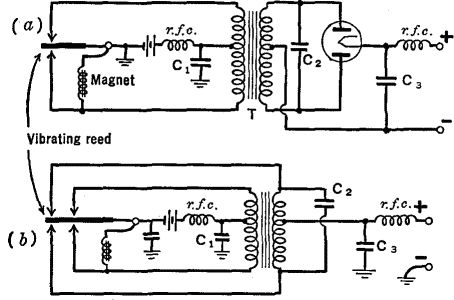| Basic Radio is a free introductory textbook on electronics based on tubes. See the editorial for more information.... |

|

Home  Basic Circuits Basic Circuits  Rectifiers Rectifiers  Vibrator Units Vibrator Units |
||||






|
||||
|
Vibrator UnitsAuthor: J.B. Hoag A common source of power for portable electronic circuits is the 6-volt automobile-type storage battery. This low voltage may be stepped-up to a suitably high value by means of a vibrator and transformer unit, as shown in Fig. 11 J, after which it is rectified either by means of a diode, as in (a), or mechanically, as in (b), and then filtered in the usual manner.
C1 (0.5 to 1 μfd., 50 volts rating). The other hash filter consists of r.f.c. (2.5 millihenry choke) and condenser C3 (0.01 to 0.1 μfd.). The circuit of Fig. 11 J(a) is of the so-called non-synchronous type while that of (b) is of the so-called synchronous type. In the latter, the double-diode rectifier is replaced by an extra pair of contacts on the vibrator.
|
||||
Home  Basic Circuits Basic Circuits  Rectifiers Rectifiers  Vibrator Units Vibrator Units |
||||
Last Update: 2009-11-01


